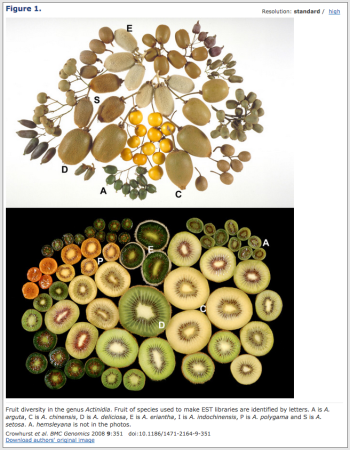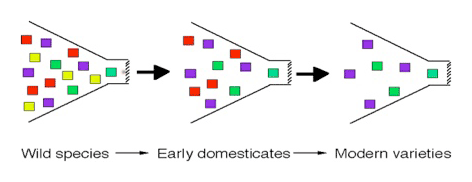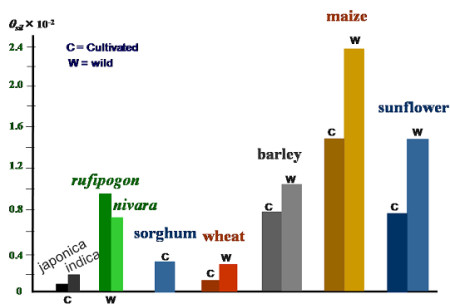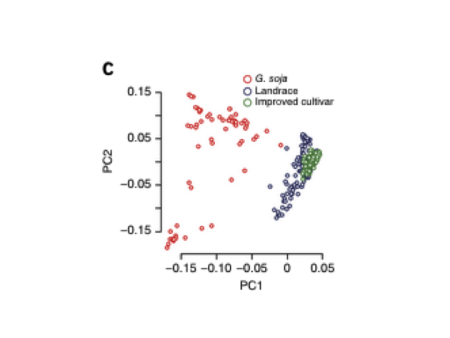 I love photos of weird plants, and the Facebook group Rare Fruit-Rare Edible Plants is a great place to find them. Once in a while, you even get a photo of diversity in a weird plant, which is even better. Case in point is this great visual summary of diversity in Actinidia. Except of course the Facebook version had no caption, which was annoying as hell. Fortunately, thanks to Google Image Search, I was able to track down the original source, a 2008 paper in BMC Genomics. Now, where can I get some of these to taste?
I love photos of weird plants, and the Facebook group Rare Fruit-Rare Edible Plants is a great place to find them. Once in a while, you even get a photo of diversity in a weird plant, which is even better. Case in point is this great visual summary of diversity in Actinidia. Except of course the Facebook version had no caption, which was annoying as hell. Fortunately, thanks to Google Image Search, I was able to track down the original source, a 2008 paper in BMC Genomics. Now, where can I get some of these to taste?
Bottleneck slides
Try and find an illustration of the domestication bottleneck — to put in a slide for a presentation, say — and likely as not you end up with some variation on a classic theme, this particular version being from the great Teacher-Friendly Guide to the Evolution of Maize:

That’s fine for some purposes, but sometimes you want real data, and then you might use this:

But I don’t really find that particularly striking, do you? And that’s why I really got excited about Fig. 1c in a recent paper about patterns of genomic diversity in a bunch of soybean accessions, ranging from wild populations to modern varieties. It’s really tiny in the paper, so I’ve blown it up here, at the expense of some quality:

I think this really shows very compellingly how the genetic diversity space shrinks and shifts as you move from wild soya to modern varieties. You don’t even really need to know that the axes are principal component scores or indeed how diversity was measured. But is this kind of diagram common out there? I can’t remember seeing anything quite this clear, and some rapid googling drew a blank too. Well, perhaps I read the wrong journals.
So here’s a question for you: what’s your favourite illustration of the domestication bottleneck, using real data? If we get a decent number of examples, I’ll try to put them all together in a post, and maybe even organize a vote.
Nibbles: Conservation course history, Language and DNA, Entomophagy blog, IPBES help, Phenomics methods database, Sustainable Nestlé, Got other milk?, NCYC
- University of Birmingham conservation course alumnus/a? This one’s for you.
- Phonemes follow human genomes. Kinda. No word on crop and livestock genomes. Yet.
- A whole blog on eating insects.
- Interesting: “Each IPBES assessment must include reference citations to indigenous knowledge, and every review panel must include experts in this.”
- Curated list of methods in Plant Phenotyping and Phenomics.
- Nestlé’s sustainable agriculture guy visits CIAT, plants coconut, talks supply chains.
- Camelcino, anyone?
- UK yeast genebank reaches totally arbitrary milestone.
Nibbles: Food security course, Food foodprint infographic, Ganja genomics, Hop hope, French collections, Forest control, Australian poppies, Paraguayan resistance, Cacao improvement, Hot pepper, Endogenous viruses, Biofortification
- Our Hungry Planet: Agriculture, People and Food Security. Free online course from University of Reading.
- What if people in country X ate the same diet as people in country Y?
- The Man wants to fingerprint your stash.
- Or maybe fragrantly hopped beer is your poison?
- A new one on me: Conservatoire des Collections Végétales Spécialisées (CCVS).
- All politics is local. All control of forestry enterprises ought to be.
- Victoria takes to the poppy. Afghanistan unavailable for comment.
- The small farmers of Paraguay holding back the flood of soy. Or trying to.
- The promise — and curse — of CCN 51. And some context on the whole peak chocolate thing.
- Wait, some people think Bhut Jolokia is a cool name?
- The grapevine has gone viral. Millions of years ago.
- Global Panel of Wise Agricultural People says to biofortify your crops.
Brainfood: Amorphophallus diversity, Physiological phenotyping, Jatropha diversity, Ass origins, Prickly lettuce diversity, Sugarcane in vitro, Pennisetum diversity, ABS and Norway, Seed storage behaviour, Barley diversity, Lentil diversity, Bilberry characterization, Potato genomics, Asian horse ABS
- Cytotaxonomic investigations to assess diversity and evolution in Amorphophallus Blume ex Decne. (Araceae). Out of 25 accessions and 7 wild species, “A. dubius may be the immediate ancestor of cultivated forms.”
- Physiological phenotyping of plants for crop improvement. High-throughput phenotyping is only the start.
- Geographic origin is not supported by the genetic variability found in a large living collection of Jatropha curcas with accessions from three continents. 900 global accessions fall into 2 genetic groups, but not related to geography.
- Genetic diversity of donkey populations from the putative centers of domestication. Sudan and/or Yemen.
- Genetic and Biochemical Evaluation of Natural Rubber from Eastern Washington Prickly Lettuce (Lactuca serriola L.). I look forward to seeing those rubber lettuce plantations.
- An approach on the in vitro maintenance of sugarcane with views for conservation and monitoring of plant nuclear DNA contents via flow cytometry. It’s possible to conserve sugarcane in vitro, but it won’t be straightforward.
- Geographical Gaps and Diversity in Deenanath Grass (Pennisetum pedicellatum Trin.) Germplasm Conserved at the ICRISAT Genebank. 194 provinces in 21 countries? That’s a lot of gaps.
- Realizing access and benefit sharing from use of genetic resources between diverging international regimes: the scope for leadership. As supplied by Norway, that is.
- Classification of seed storage behaviour of 67 Amazonian tree species. 1000-seed weight and seed moisture content at shedding are good, together, at predicting seed storage behaviour.
- Genetic Diversity and Population Structure in a Legacy Collection of Spring Barley Landraces Adapted to a Wide Range of Climates. 10 climatic clusters.
- Assessment of genetic variation within a global collection of lentil (Lens culinaris Medik.) cultivars and landraces using SNP markers. Geographic pattern for commercial varieties, but not for landraces.
- Omne Ignotum pro Magnifico: characterization of commercial Bilberry extracts to fight adulteration. That would be Vaccinium myrtillus. You need to keep a sharp eye on the whole production process.
- The Contribution of the Solanaceae Coordinated Agricultural Project to Potato Breeding. It boils down to the Infinium 8303 Potato SNP Array, and it’s contribution to potato breeding has apparently been important.
- Horses as Sources of Proprietary Information: Commercialization, Conservation, and Compensation Pursuant to the Convention on Biological Diversity. You need a value chain with “a sequence of proprietary rights agreements governed and regulated by both tangible and intangible property regimes.” Well, yeah.